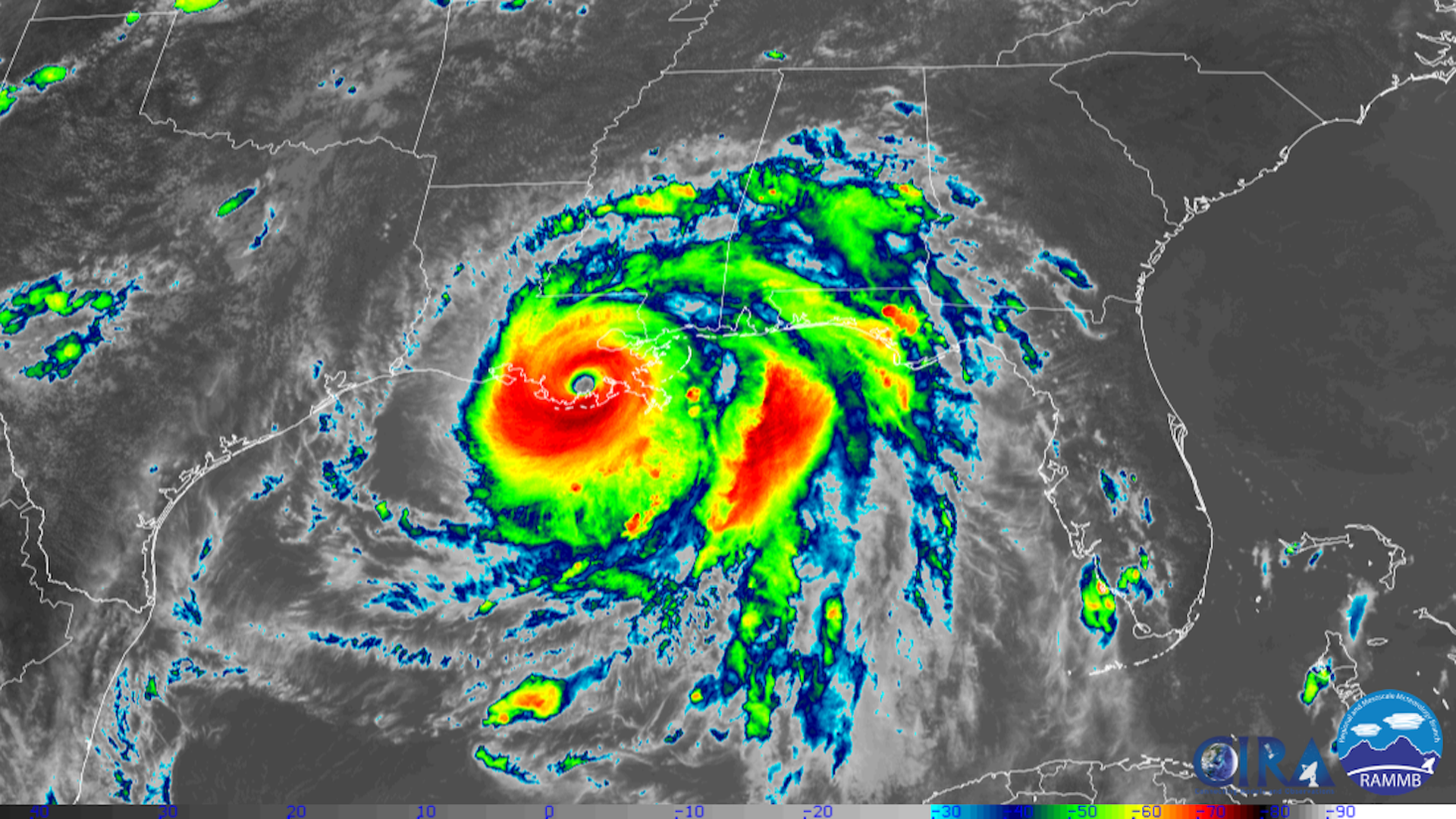| | | | | | | Presented By Cognite | | | | Axios Generate | | By Ben Geman and Andrew Freedman ·Aug 30, 2021 | | 🌅 Welcome back. Today's Smart Brevity count is 1,356 words, 5.5 minutes. 📈 Data point of the day: 3. The total number of "major" (Category 3 or stronger) hurricanes that have hit Louisiana in the past two years. 🚨 Situational awareness: Via CNN, you can help those affected by Hurricane Ida here. 🎧 Listen to Andrew discuss the storm's differences from Hurricane Katrina on the Axios Today podcast, with guest host Hope King. 🎶 This month marks 40 years since late R&B giant Luther Vandross released his debut album "Never Too Much," which provides today's intro tune... | | | | | | 1 big thing: Behind Hurricane Ida's explosive intensification |  Data: EPA; Chart: Sara Wise/Axios Hurricane Ida jumped from a 105-mph Category 2 hurricane on Saturday to a high-end Category 4 monster by Sunday morning, a feat enabled by climate change, timing and bad luck, Andrew writes. Why it matters: Understanding how Mother Nature's most powerful storms are changing is key to learning how to better protect coastal communities around the world. By the numbers: One key measure of storm intensity is the minimum central air pressure (the lower the pressure, the stronger the storm). In this case, the pressure dropped by a whopping 41 millibars in just 14 hours, between 5pm ET Saturday and 7am ET Sunday. The intrigue: Hurricane Ida's explosive intensification was due to three main factors, with climate change mainly affecting the first two — and most decisive — of these three: - An ample supply of deep, bathtub-like warm water. The presence of the Gulf of Mexico loop current added more fuel, and the timing: Gulf waters tend to be at their hottest at this time of year.
- Abundant moisture in the atmosphere, as dry air can get entrained into storms and disrupt their intensification process.
- A lack of wind shear or any other atmospheric factor that could stifle the storm's towering thunderstorms from forming a concentric ring around the eye.
How it works: Hurricanes are heat engines, feasting off warm waters. - The vast majority of extra heat going into the climate system from burning fossil fuels is being absorbed by the oceans, and the seas are warming as a result.
- So are air temperatures. For every 1°C (1.8°F) of temperature increase, there is about a 7% increase in the water holding capacity of the atmosphere.
- These two trends are causing hurricanes and tropical storms to dump more water, on average, than they used to, and for there to be a greater proportion of high-end Category 3, 4 and 5 hurricanes in some ocean basins.
Context: Sufficient recent studies have been published on these trends in peer-reviewed journals to point to an emerging consensus noted in the recent U.N. IPCC report. - For example, a 2019 study in the journal Nature found there was a trend in the Atlantic Ocean toward more rapidly intensifying storms between 1982 and 2009, which it attributed to human-induced climate change.
The bottom line: In the end, the fact that this storm hit Port Fourchon, Louisiana, also comes with a dose of bad luck and bitter irony. - The irony stems from the landfall location, Port Fourchon, which is home to critical facilities for operating deepwater oil and gas drilling rigs in the Gulf of Mexico. More than 1.5 million barrels of crude oil per day are transported via pipelines and through the port.
- Yet it's the burning of fossil fuels that helped make this storm so strong, and so badly damaged the port.
Read more |     | | | | | | Bonus: Ida hour by hour |  Data: NOAA Best track database; Chart: Sara Wise/Axios In 24 hours, the minimum air pressure in Hurricane Ida plummeted by 52 millibars, starting from 8am ET Saturday, Andrew writes. During that period, the storm's maximum sustained winds shot upward by 65 mph, exceeding the National Hurricane Center's definition of rapid intensification, which is a wind increase by at least 35 mph in 24 hours. |     | | | | | | 2. What we know: Ida's energy impact |  | | | Category 4 Hurricane Ida after making its two landfalls in Louisiana on Aug. 29, 2021. (CIRA/RAMMB) | | | | Hurricane Ida has left over 1 million homes and businesses without power, mostly in Louisiana, after making landfall as a powerful Category 4 storm on Sunday, Ben writes. Driving the news: Ida also greatly disrupted Gulf of Mexico and Gulf coast oil-and-gas and petrochemical operations, but the full scope of the damage — and environmental hazards — will take time to assess. The big picture: All of New Orleans lost power last night after Entergy, the utility that serves the city, said the storm's "catastrophic intensity" knocked transmission offline. Some areas may be without power for weeks, it said. - On the oil-and-gas front, as of Sunday, 97% of Gulf of Mexico oil production and 94% of natural was shut down in advance of the storm and companies evacuated many workers, per the Interior Department.
- At least nine refineries in Louisiana halted or reduced operations in advance of the storm, accounting for around 2.3 million barrels per day of capacity, or 13% of the U.S. total, per the Energy Department.
- Colonial Pipeline, the huge eastern U.S. fuel artery, temporarily shut lines that run from Texas to North Carolina as a precautionary measure.
What we're watching: The human and environmental toll, but also the market effects as refineries assess the damage and restart timelines. Yes, but: Oil prices have not surged despite the outages. That's likely due to several factors, including... - Supplies in storage and traders are not expecting prolonged offshore production and transportation disruptions despite damage to regional port infrastructure.
- The Gulf's share of U.S. oil production has fallen thanks to the shale boom. Also, the Delta variant's spread is bearish for prices.
|     | | | | | | A message from Cognite | | The countdown to 2050 has begun | | |  | | | | What are the global leaders of technology and industry doing to drive the energy transition, digitalize legacy industries, and reach net-zero by 2050? Find out at Ignite Talks, one of the world's largest industrial technology and digitalization conferences, September 21-23. Register here. | | | | | | 3. Why Rivian's IPO is worth watching |  | | | Rivian R1T electric truck. Photo: Rivian | | | | Rivian, the well-financed electric vehicle startup about to start delivering its pickup truck, says it has filed plans to go public with securities regulators, Ben writes. The big picture: The company is quite well-capitalized. Rivian's financial backers include Ford, Amazon and BlackRock. - Rivian's recent $2.5 billion funding round brings the total amount raised above $10 billion.
- It's also breaking from the pack of EV startups going public with apparent plans to eschew listing via merger with a special purpose acquisition company, the route many others are taking.
- Bloomberg reports that Rivian is hoping to do an IPO around the Thanksgiving timeframe and hopes for an $80 billion (!) valuation, while the NYT says it's aiming for $70 billion.
- Those numbers are eye-popping! Consider that Ford's market capitalization is currently $52 billion.
The intrigue: The EV market is getting crowded even as EVs remain a very small slice of auto sales. But Rivian, flush with cash, has reason for confidence, analysts said in response to Friday's announcement. - "[W]e believe Rivian is an ideal position to go public as investor enthusiasm for EVs is high," PitchBook analyst Asad Hussain said.
- "Similar to Tesla, Rivian's premium market valuation reflects its ownership of the entire value chain, including direct-to-consumer sales, charging networks, and commercial vehicle business," Hussain said in a note.
Catch up fast: Rivian will begin deliveries of its pickup truck next month, with plans to start delivering its SUV this fall. The Michigan-based startup also has a large deal with Amazon to build up to 100,000 electric delivery vehicles this decade. |     | | | | | | 4. Cooling the Great Barrier Reef |  | | | A green turtle swims among the corals of the Great Barrier Reef in Australia. Photo: Jonas Gratzer/LightRocket via Getty Images | | | | A new study in Nature explores how scientists are creating artificial clouds in an effort to shield Australia's Great Barrier Reef, Axios' Bryan Walsh reports. Why it matters: The Great Barrier Reef is the largest coral reef system in the world — and it's under tremendous threat from climate change. How it works: A group of scientists in Australia has conducted preliminary trials to blow ocean mist into the sky and artificially brighten clouds. - The work is meant to prove the idea that juicing clouds could reduce sunlight hitting the waters around the reef.
The big picture: The field trials — an early experiment in geoengineering that purposefully alters the climate — suggest the technology may work even better than computer models suggested, offering a rare ray of hope for the oceans. Sign up here for Bryan's Axios Future newsletter. |     | | | | | | 5. Catch up fast: Hydrogen, Canada, EVs | | Investment: "China's Sinopec Corp plans to spend 30 billion yuan ($4.6 billion) on hydrogen energy by 2025 as the state oil and gas major pivots to producing natural gas and hydrogen as part of becoming a carbon-neutral energy provider by 2050." (Reuters) Policy: "Prime Minister Justin Trudeau said his government would require Canada's oil and gas sector to set benchmarks to reduce emissions if he is re-elected." (Bloomberg) Finance: "Ola Electric is in advanced talks to raise between $250 million to $500 million in a new financing round as the Indian firm looks to scale its electric vehicle manufacturing business in the South Asian market." (TechCrunch) |     | | | | | | A message from Cognite | | The countdown to 2050 has begun | | |  | | | | What are the global leaders of technology and industry doing to drive the energy transition, digitalize legacy industries, and reach net-zero by 2050? Find out at Ignite Talks, one of the world's largest industrial technology and digitalization conferences, September 21-23. Register here. | | | | Thanks so much for reading! Please tell your friends to sign up for this newsletter here, and we'll see you tomorrow. |  | | It'll help you deliver employee communications more effectively. | | | | | | Axios thanks our partners for supporting our newsletters. If you're interested in advertising, learn more here.
Sponsorship has no influence on editorial content. Axios, 3100 Clarendon Blvd, Suite 1300, Arlington VA 22201 | | | You received this email because you signed up for newsletters from Axios.
Change your preferences or unsubscribe here. | | | Was this email forwarded to you?
Sign up now to get Axios in your inbox. | | | | Follow Axios on social media:    | | | | | |









No comments:
Post a Comment